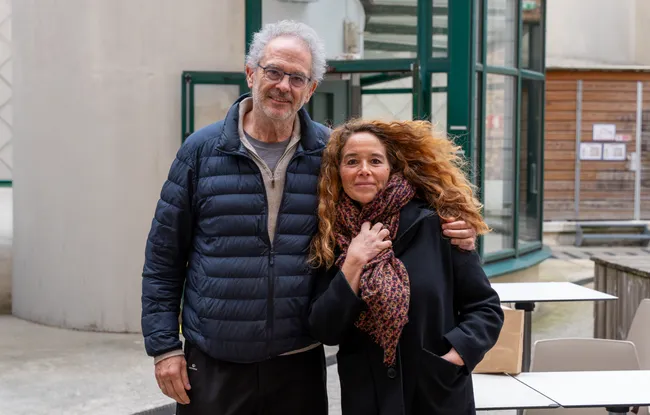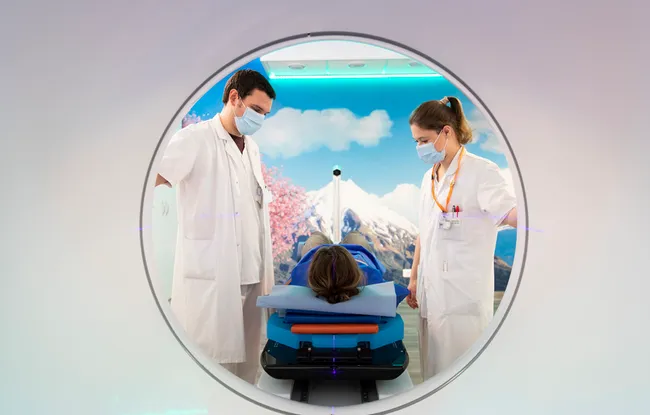- Home >
- Institut Curie News >
- Radiotherapy At Institut Curie: a boost for state-of-the-art innovation
Over 70% of cancer treatments include radiotherapy sessions, proving that this treatment is a crucial tool in the tumor-fighting arsenal.
Historic cradle of radiotherapy, Institut Curie is also building its future.
For World Cancer Day, Institut Curie presents the groundbreaking technologies (Mini-beam, FLASH, etc.) that are emerging from its research laboratories and announces a major investment plan to offer more pioneering technologies in the field of radiotherapy. With the sole aim of better treatment for cancer patients, including children, with increasingly precise, conservative and tailored treatments that guarantee better quality of life for patients.
Over 190,000 patients have their cancer treated with radiotherapy in France each year[1]. Used alone or in combination with surgery or chemotherapy, these sessions involve local delivery of rays (electrons, photons, protons) that destroy the cancer cells by causing damage to their DNA. However, radiotherapy can also cause damage to certain neighboring healthy tissues and lead to after-effects.
Radiotherapy presents a twofold challenge: to increase tumor-fighting effectiveness and to reduce side effects. There are some promising leads in these fields at Institut Curie.
The historic birthplace of radiotherapy, Institut Curie is now looking to state-of-the-art innovation in terms of innovative research, development of its technical platform, and its technological performance. Researchers and physicians at the institute are joining forces to offer new radiotherapy methods and better treatment combinations to as many patients as possible, including children
Prof. Thierry Philip, Chairman of the Executive Board at Institut Curie.
New and increasingly innovative equipment
With Europe’s most comprehensive technical radiotherapy platform, Institut Curie is France’s leading proton therapy center. In 2023, Institut Curie is launching a broad-ranging radiotherapy program involving a major investment plan to boost the modernization of its technical platform and offer its patients the most innovative and groundbreaking techniques. This major plan involves 56 million euros invested over 6 years, covering all radiotherapy equipment and all Institut Curie sites: Paris, Saint-Cloud and Orsay.
The ultra-sophisticated techniques that will increasingly help optimize patient care include stereotactic radiotherapy (high-precision, high-dose irradiation), respiratory-gated radiotherapy (which adapts to movements due to breathing, thus protecting healthy tissues) and adaptive radiotherapy (adaptation of the treatment plan according to variations observed during irradiation).
Our radiotherapy investment plan is an ambitious project that will strengthen Institut Curie’s innovation in medical physics as well as in engineering sciences and imaging. Our future ultra-sophisticated radiotherapy equipment will enable us to optimize treatments and care for our patients, who will enjoy increasingly precise, complementary and conservative techniques for as many locations as possible.
Prof. Steven Le Gouill, director of the Hospital Group at Institut Curie.
A new era for radiotherapy: adaptive and tailored
The stakes of radiotherapy care have shifted dramatically in recent years, due to medical and technological progress, and this sea change will continue in the coming years. Patients are now treated and monitored over the long term. Some treatments such as repeat irradiation are increasingly common, and this changes patient care.
Adaptive radiotherapy will be a routine clinical tool, enabling radiotherapists to adapt to development of the tumor as irradiation is happening, but also to the patient’s anatomy or position, to better protect the healthy tissues. And these techniques will be made possible by integrating artificial intelligence software or embedded imaging systems.
Our project will drive Institut Curie to offer optimum treatment for patients of course, but also for health professionals. Today, thanks to the latest generation equipment, we have the means to interpret all the data, to predict how the disease evolves and to anticipate increasingly complex treatments to serve our patients.
Prof. Gilles Créhange, head of Institut Curie’s oncology-radiotherapy department.
One of the innovative approaches already used in a clinical setting at Institut Curie is hypofractionated radiotherapy, offered since 2021. It involves reducing the number of sessions to offer greater comfort to patients, particularly elderly breast cancer patients without high risk of recurrence. Another typical example of care at Institut Curie is a stereotaxis technique (“concentrated” radiotherapy) for some patients with localized prostate cancer. It involves just 5 sessions spread out over 1 1/2 weeks (compared with conventional treatment lasting 2 months) and reduces side effects. In more advanced cancer cases, Institut Curie specialists offer a new approach, known as “boost”, which combines external radiotherapy with brachytherapy[2].
Revolutionary research for breakthrough technologies
The international community has not seen this type of buzz in radiotherapy for decades, with totally innovative technologies, which in the coming years could change the landscape for patients. Although much progress has been made in terms of imaging precision, ballistics and dosimetry, new dose delivery methods, with new biological effects on tissues, are paving the way for promising therapeutic solutions to target tumors that until now have been radio-resistant, and to considerably reduce long-term after-effects. Institut Curie’s teams are pioneers in the emergence of revolutionary radiotherapy solutions.
Institut Curie’s DNA is that of an osmosis between interdisciplinary research and clinical practice. Original and promising therapies are emerging from this rivalry. Recent research breakthroughs at Institut Curie in physics and radiobiology, but also in terms of image analysis combined with artificial intelligence, pose new challenges which are creating a buzz in the international community.
Prof Alain Puisieux, director of the Institut Curie Research Center.
Mini-beams: a true paradigm shift
A new dose delivery system has been discovered by the “New Approaches in Radiotherapy” team headed by Yolanda Prezado, a physicist and CNRS research director. Indeed, her team - SIRIC accredited (Integrated cancer research site) - is a pioneer in research on proton mini-beam radiotherapy (pMBRT): a strategy that uses submillimetric proton beams and is proving very promising for treating radioresistant tumors with a poor prognosis, particularly in pediatrics.
FLASH radiotherapy causes a furor
Discovered in 2014 in Institut Curie laboratories at Orsay by the team of Vincent Favaudon, a radiobiology researcher at Inserm, “FLASH” is a radiotherapy technique where ultra-high dose rate irradiation (10 Gray or more, equal to the dose received in one week of conventional radiotherapy) is delivered in a fraction of a second, i.e. 1,000 to 10,000 times more intense than conventional radiotherapy.
This technique destroys the tumor cells while sparing the healthy tissue and if the next research steps lead to approval for future clinical application, FLASH radiotherapy will provide new opportunities for cancer treatment. Studies are conducted on FLASH radiotherapy at Institut Curie, on different types of electron and proton particle accelerators.
“Bait” molecules which increase the effectiveness of radiotherapy
At Institut Curie, the “Repair, Radiation and Innovative Anti-cancer Therapies” team, thanks to the work of Marie Dutreix, emeritus research director at the CNRS, has developed a unique new class of drugs, namely Dbait molecules, which increase the effectiveness of radiotherapy. When seeking to understand the resistance to radiation observed in almost 20% of patients, along with her team she developed these small molecules which resemble damaged DNA, tricking the cells into thinking that the quantity of damage to repair after radiotherapy or chemotherapy treatment is much higher than is actually the case.
Other teams at Institut Curie are involved in research particularly in imaging, IT, and mathematics. Since the future of anti-cancer therapies lies in combining treatments, a number of projects are underway at Institut Curie that combine radiotherapy-immunotherapy, radiotherapy and nanoparticles, FLASH and Dbaits, in order to build a battery of tools against cancer.
Radiotherapy at the Institut Curie: a legacy of innovation
More than 100 years ago, Marie Curie, a physicist by training, was convinced that ionizing radiation could be a weapon of choice in the fight against cancer. Since then, radiotherapy has continued to benefit from technological progress.
► Discover the history of radiotherapy
[2] Brachytherapy involves putting radioactive sources in contact with or inside tumors, for more targeted treatment. It can be prescribed for certain prostate, gynecological, anal canal and eye cancers.
Research News
Discover all our news
Celebration
The Immunity and Cancer research unit (U932) celebrates its twentieth anniversary
12/12/2025
Artificial Intelligence
08/12/2025



